1. Abei H. Catalase in the Method of Enzymatic Analysis. 1974. Vol. 2. New York. USA: Academic Press;p. 673–684.
2. Alekel DL, Germain A, Peterson CT, Hanson HB, Stewart JW, Toda T. Isoflavone-rich soy protein attenuates bone loss in the lumber spine of premenopausal women. Am J Clin Nutr. 2000; 72:844–852. PMID:
10966908.
3. Ali AA, Velasquez MT, Hansen CT, Mohamed AI, Bhathena SJ. Modulation of carbohydrate metabolism and peptide hormones by soybean isoflavones and probiotics in obesity and diabetes. J Nutr Biochem. 2005; 16:693–699. PMID:
16081264.

4. Allain CC, Poon LS, Chen CS, Richmond W. Enzymatic determination of total serum cholesterol. Clin Chem. 1974; 20:470–475. PMID:
4818200.

5. Alper G, Olukman M, İrer S, Cağlayan O, Duman E, Yılmaz C, Ülker S. Effect of vitamin E and C supplementation combined with oral antidiabetic therapy on the endothelial dysfunction in the neonatally streptozotocin injected diabetic rat. Diabetes Metab Res Rev. 2006; 22:190–197. PMID:
16216038.

6. Al-Shamaony L, Al-Khazraji SM, Twailiv IA. Hyperglycemic effect of
Artemisia herba alba. II. Effect of a valuable extact on some blood parameters in diabetic animals. J Ethnopharmacol. 1994; 43:167–171. PMID:
7990489.
7. Anderson JJ, Anthony MS, Cline JM, Washburn SA, Garner SC. Health potential of soy isoflavones for menopausal women. Public Hearth Nutr. 1998; 2:489–504.

8. Anderson JW, Smith BM, Washnock CS. Cardiovascular and renal benefits of dry bean and soybean intake. Am J Clin Nutr. 1999; 70:464S–474S. PMID:
10479219.

9. Anthony MS, Clarkson TB, Hughes CL, Morgan TM, Burke GL. Soybean isoflavones improve cardiovascular risk factors without affecting the reproductive system of peripubertal rhesus monkeys. J Nutr. 1996; 126:43–50. PMID:
8558324.

10. Arjmandi BH, Alekel L, Hollis BW, Amin D, Stacewicz-Sapuntzakis M, Guo P, Kukreja SC. Dietary soybean protein prevents bone loss in an ovariectomized rat model of osteoporosis. J Nutr. 1996; 126:161–167. PMID:
8558297.

11. Bieri G, Toliver JJ, Catignani GL. Simultaneous determination of alpha-tocopherol and retinol in plasma or red blood cells by high pressure liquid chromatography. Am J Clin Nutr. 1979; 32:2143–2149. PMID:
484533.
12. Bradford MM. A rapid and sensitive method for the quantitation of microgram quantities of protein utilizing the principle of protein-dye binding. Anal Biochem. 1976; 72:248–254. PMID:
942051.

13. Bucolo G, David H. Quantitative determination of serum triglycerides by use of exzymes. Clin Chem. 1973; 19:476–482. PMID:
4703655.
14. Duncan AM, Underhill KE, Xu X, Lavalleur J, Phipps WR, Kurzer MS. Modest hormonal effects of soy isoflavones in postmenopausal women. J Clin Endocirnol Metab. 1999; 84:3479–3484.

15. Eldridge AC, Kwolek WF. Soybean isoflavones: Effect of environment and variety on composition. J Agric Food Chem. 1983; 31:394–396. PMID:
6682871.

16. Exner M, Hermann M, Hofbauer R, Kapiotis S, Quehenberger P, Speiser W, Held I, Gmeiner BM. Genistein prevents the glucose autoxidation mediated atherogenic modification of low density lipoprotein. Free Radic Res. 2001; 34:101–112. PMID:
11234992.

17. Finley PR, Schifman RB, Williams RJ, Luchti DA. Cholesterol in high-density lipoprotein : Use of mg
2+/dextran sulfate in its measurement. Clin Chem. 1978; 24:931–933. PMID:
207463.
18. Folch JM, Lees M, Stanley GHS. A simple method for the isolation and purification of total lipids from animal tissue. J Bio Chem. 1957; 226:497–509. PMID:
13428781.
19. Gallaher DD, Csallany AS, Shoeman DW, Olson JM. Diabetes increases excretion of urinary malonaldehyde conjugates in rats. Lipids. 1993; 28:663–666. PMID:
8355596.

20. Griesmacher A, Kindhauser M, Andert SE, Schreiner W, Toma C, Knoebl P, Pietschmann P, Prager R, Schnack C, Schernthaner G, Mueller MM. Enhanced serum level of thiobarbituricacid-reactive substances in diabetic mellitus. Am J Med. 1995; 98:469–475. PMID:
7733126.
21. Hsu CS, Chiu WC, Yeh SH. Effects of soy isoflavone supplementation on plasma glucose, lipids and antioxidant enzyme activities in streptozotocin-induced diabetic rats. Nutr Res. 2003; 23:67–75.

22. Jayagopal V, Albertazzi P, Kilpatrick ES, Howarth EM, Jennings PE, Hepburn DA, Atkin SL. Beneficial effects of soy phytoestrogen intake in postmenopausal women with type 2 diabetes. Diabetes Care. 2002; 25:1709–1714. PMID:
12351466.

23. Jenkins DJ, Kendall CW, Jacson CJ, Connelly PW, Parker T, Faulkner D, Vidgen E, Cunnane SC, Leiter LA, Josse RG. Effects of high- and low-isoflavone soyfoods on blood lipids, oxidized LDL, homocysteine, and blood pressure in hyperlipidemic men and women. Am J Clin Nutr. 2002; 76:365–372. PMID:
12145008.

24. Kaleem M, Asif M, Ahmed QU, Bano B. Antidiatic and antioxidant activity of
Annona squamosa extract in streptozotoc-ininduced diabetic rats. Singapore Med J. 2006; 47:670–675. PMID:
16865205.
25. Kaneto H, Fujii J, Myint T, Miyazawa N, Islam KN, Kawasaki Y, Suzuki K, Nakamura M, Tatsumi H, Yamasaki Y, Taniguchi N. Reducing sugars trigger oxidative modification and apoptosis in pancreatic β-cells by provoking oxidative stress through the glycation reaction. Biochem J. 1996; 320:855–863. PMID:
9003372.

26. Kesavulu MM, Rao BK, Giri R, Vijaya J, Subramanyam G, Apparao C. Lipid peroxidation and antioxidant enzyme status in Type 2 diabetics with coronary heart disease. Diabetes Res Clin Pract. 2001; 53:33–39. PMID:
11378211.

27. Kim JS, Kwon CS. Estimated dietary isoflavone intake of Korean population based on National Nutrition Survey. Nutr Res. 2001; 21:947–953. PMID:
11446978.

28. Kirk EA, Sutherland P, Wang SA, Chait A, LeBoeuf RC. Dietary isoflavones erduce plasma cholesterol and atherosclerosis in C57BL/6 mice but not LDL receptor-deficient mice. J Nutr. 1998; 128:954–959. PMID:
9614153.
29. Kudou S, Fluery Y, Welti D, Magnolato D, Uchida T, Kitamura K, Okaubo K. Malonyl isoflavone glycosides in soybean seeds (Glycine max Merrill). Agric Biol Chem. 1991; 55:2227–2233.
30. Kuiper JM, Carrison B, Grandien K, Enmark E, Haggblad J, Nilsson S, Gustafsson JA. Comparison of the ligand binding specificity and transcript tissue distribution of estrogen receptors alpha and beta. Endocrinology. 1997; 139:4252–4257. PMID:
9751507.
31. Lee HS, Choi MS, Lee YK, Park SH, Kim YJ. Astudy on the development of high-fiber supplements for the diabetic patients-Effect of seaweed supplementation on the lipid and glucose metabolism in streptozotocin-induced diabetic rats. The Korean Journal of Nutrition. 1996; 29:296–306.
32. Lee JS. Effects of soy protein and genistein on blood glucose, antioxidant enzyme activities and lipid profile in streptozitocin-induced diabetic rats. Life Sci. 2006; 79:1578–1584. PMID:
16831449.
33. Lee KA. Effects of isoflavone-rich bean sprout on the metabolism of diabetic rats. 2002. Kyungpook National University of Korea;MS thesis.
34. Lee SK, Lee MJ, Yoon S, Kwon DJ. Estimated isoflavone intake from soy products in Korean middle-aged women. Journal of the Korean Society of Food Science and Nutrition. 2000; 29:948–956.
35. Liu D, Zhen W, Yang Z, Carter JD, Si H, Reynolds KA. Genistein acutely stimulates insulin secretion in pancreatic β-cells through a Camp-dependent protein kinase pathway. Diabetes. 2006; 55:1043–1050. PMID:
16567527.

36. Marklund S, Marklund G. Involvement of the superoxide anion radical in the autoxidation of pyrogallol and a covenient assay for superoxide dismutase. Eur J Bio Chem. 1974; 47:469–474.
37. Morel DW, Chisolm GM. Antioxidant treatment of diabetic rats inhibits lipoprotein oxidation and cytotoxicity. J Lipid Res. 1989; 30:1827–1834. PMID:
2621411.

38. Naaz A, Yellayi S, Zakroczymski MA. The soy isoflavone genistein decreaseds adipose deposition in mice. Endocrinology. 2003; 144:3315–3320. PMID:
12865308.
39. Nelson GJ, Morris VC, Schmidt PC, Levander O. The urinary excretion of thiobarbituric acid reactive substances and malondialdehyde by normal adult males after consuming a diet containing solmon. Lipids. 1993; 28:757–761. PMID:
8377591.
40. Ohta n, Kuwata G, Akahori H, Watanabe T. Isolation of a new isoflavone acely glucoside, 6"-O-acetylgenistin, from soybeans. Agric Biol Chem. 1980; 44:469–470.
41. Packer L. The role of anti-oxidative treatment in diabetes mellitus. Diabetologia. 1993; 36:1212–1213. PMID:
8270140.

42. Paglia PE, Valentine WN. Studies on quantitative and qualitative characterization of erythrocyte glutathione peroxidase. J Lab Clin Med. 1967; 70:158–169. PMID:
6066618.
43. Palmeira CM, Santos DL, Seica R, Moreno AJ, Santos MS. Enhanced mitochondrial testicular antioxidant capacity in Goto-Kakizaki diabetic rats: role of coenzyme Q. Am J Physiol Cell Physiol. 2001; 281:C1023–C1028. PMID:
11502580.

44. Park SH, Lee HS. Effects of legume supplementation on the glucose and lipid metabolism and lipid peroxidation in streptosotoc-ininduced diabetic rats. The Korean Journal of Nutrition. 2003; 36:425–436.
45. Pratt D, Pietro CD, Porter W, Giffee JW. Phenolic antioxidants of soy protein hydrolyzates. J Food Sci. 1981; 47:24–27.

46. Raines EW, Ross R. Biology of atherosclerotic plaque formation possible role of growth factors in lesion development and the potential impact of soy. J Nutr. 1995; 125:624S–630S. PMID:
7884544.
47. Ravi K, Ramachandran B, Subramanian S. Effect of Eugenia jambolana seed kernel on antioxidant defense system in streptozotocin-induced diabetes in rats. Life Sci. 2004; 75:2717–2731. PMID:
15369706.

48. Sale FD, Marchesini S, Fishman PH, Berra B. A sensitive enzymatic assay for determination of cholesterol in lipid extracts. 1984. New York. USA: Academic Press Inc.;p. 347–350.
49. Setchell KDR, Cassidy A. Dietary isoflavones: Biological effects and relevance to human health. J Nutr. 1999; 129:758S–767S. PMID:
10082786.

50. Seven A, Güzel S, Scymen O, Civelek S, Bolayırl M, Uncu M, Gurçak B. Effects of vitamin E supplementation on oxidative stress in streptozotocin induced diabetic rats: Investigation of liver and plasma. Yonsei Med J. 2004; 45:703–710. PMID:
15344213.

51. Shim JY, Kim KO, Seo BH, Lee HS. Soybean isoflavone extract improves glucose tolerance and raises the survival rate in streptozotocin-induced diabetic rats. Nutrition Research and Practice. 2007; 1:266–272.

52. Sidney PG, Bernald R. Improved menual Spectrometric procedure for determination of serum triglyceride. Clin Chem. 1973; 19:1077–1078. PMID:
4744812.
53. Somekawa Y, Chiguchi M, Ishibashi T, Aso T. Soy intake related to menopausal symptoms, serum lipids, and bone mineral density in postmenopausal Japanese women. Obst Gynecol. 2001; 97:109–115. PMID:
11152918.

54. Taladgis BG, Pearson AM, Duan LR. Chemistry of the 2-thiobarbituric acid test for determination of oxidation of oxidative rancidity in foods. J Sci Food Agric. 1964; 15:602–607.
55. Taskinen MR. Lipoprotein lipase in diabetes. Diabetes Metab Rev. 1987; 3:551–570. PMID:
3552532.

56. Teede HJ, Dalais FS, Kotsopoulos D, Liang YL, Davis S, McGrath BP. Dietary soy has both beneficial and potentially adverse cardiovascular effects: a placebo-controlled study in men and postmenopausal women. J Clin Endo Metab. 2001; 86:3053–3060.

57. The Korean Society of Food Science and Nutrition. Handbook of experiments in food science and nutrition. 2000. Seoul. Republic of Korea: Hyoil Publishing Co.;p. 480–483.
58. Tuitoek PJ, Ritter SJ, Smith JE, Basu TK. Streptozotoc-ininduced diabetes lowers trtinol-binding protein and transthyretin concentrations in rats. Br J Nutr. 1996; 76:891–897. PMID:
9014657.
59. Turk HM, Sevinc A, Camci C, Cigli A, Buyukberber S, Savi H, Bayraktar N. Plasma lipid peroxidation products and antioxidant enzyme activities in patients with type 2 diabetes mellitus. Acta Diabetol. 2002; 39:17–122.

60. Uchiyama M, Mihara M. Determination of malondialdehyde precursor in tissue by TBA test. Anal Biochem. 1978; 86:271–278. PMID:
655387.
61. Wang HJ, Murphy PA. Isoflavone content in commercial soybean foods. J Agric Food Chem. 1994; 42:1666–1673.

62. Wei H, Cai Q, Rahn RO. Inhibition of UV light- and Fenton reaction-induced oxidative DNA damage by the soybean isoflavone genistein. Carcinogenesis. 1996; 17:73–77. PMID:
8565140.
63. Wei H, Wei L, Frenkel K, Bowen R, Barnes S. Inhibition of tumor promoter-induced hydrogen peroxide formation in vitro and in vivo by genistein. Nutr Cancer. 1993; 20:1–12. PMID:
8415125.
64. Zhang M, Xie X, Lee AH, Binns CW. Soy isoflavone intake are associated with reduced risk of ovarian cancer in southeast China. Nutr Cancer. 2004; 49:125–130. PMID:
15489204.
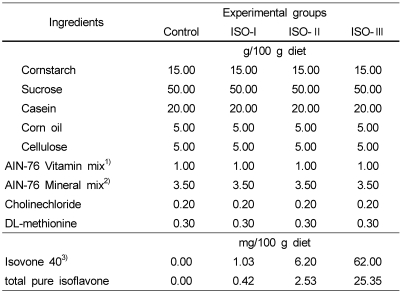

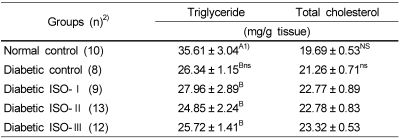
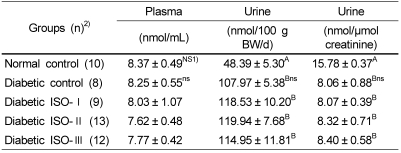
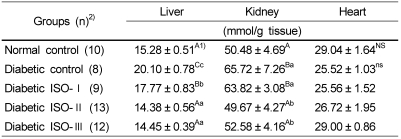
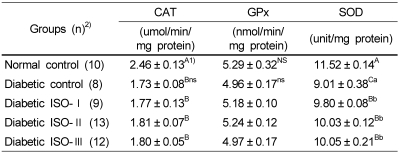
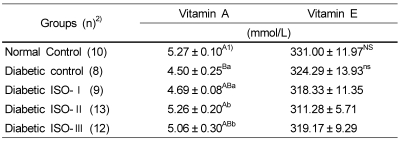




 PDF
PDF ePub
ePub Citation
Citation Print
Print


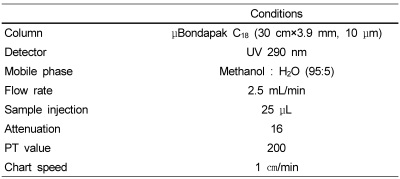
 XML Download
XML Download